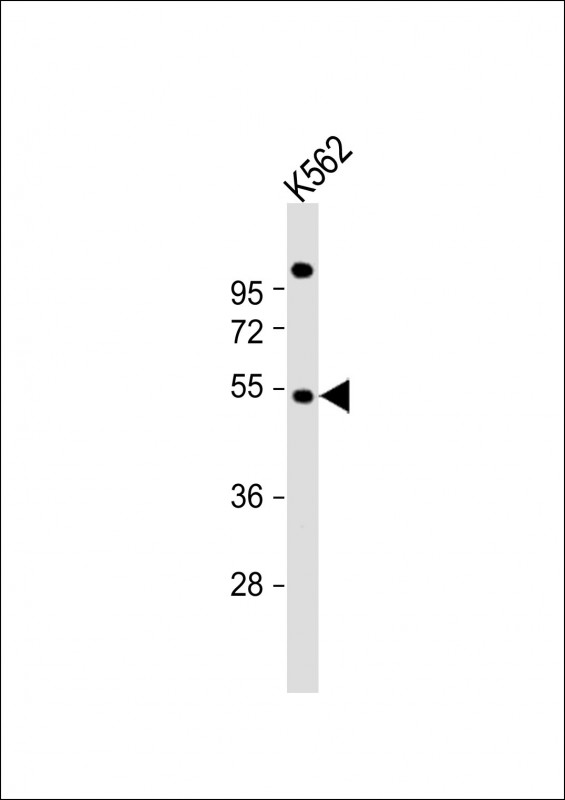
| WB | 1/1000 | Human,Mouse,Rat |
| IF | 咨询技术 | Human,Mouse,Rat |
| IHC | 咨询技术 | Human,Mouse,Rat |
| ICC | 技术咨询 | Human,Mouse,Rat |
| FCM | 咨询技术 | Human,Mouse,Rat |
| Elisa | 咨询技术 | Human,Mouse,Rat |
| Aliases | Translation initiation factor eIF-2B subunit gamma, eIF-2B GDP-GTP exchange factor subunit gamma, EIF2B3 |
| Entrez GeneID | 8891 |
| WB Predicted band size | 50.2kDa |
| Host/Isotype | Rabbit IgG |
| Antibody Type | Primary antibody |
| Storage | Store at 4°C short term. Aliquot and store at -20°C long term. Avoid freeze/thaw cycles. |
| Species Reactivity | Human |
| Immunogen | This EIF2B3 antibody is generated from rabbits immunized with a KLH conjugated synthetic peptide between 413-441 amino acids from the C-terminal region of human EIF2B3. |
| Formulation | Purified antibody in PBS with 0.05% sodium azide. |
+ +
以下是3篇与EIF2B3抗体相关的文献概览(注:部分文献可能未直接使用抗体,但涉及EIF2B3功能研究):
---
1. **文献名称**: *Mutations in genes encoding subunits of the eIF2B complex in Vanishing White Matter disease*
**作者**: van der Knaap MS, et al.
**摘要**: 研究揭示了EIF2B3等亚基基因突变与白质消融性脑病(VWM)的关联,通过免疫印迹(Western blot)实验使用EIF2B3抗体验证了患者细胞中蛋白质表达的异常,表明EIF2B复合体功能缺陷导致疾病。
2. **文献名称**: *Characterization of the Eukaryotic Initiation Factor 2B complex in cellular stress response*
**作者**: Pavitt GD, et al.
**摘要**: 该文献通过免疫沉淀(IP)和免疫荧光技术结合EIF2B3抗体,探讨了EIF2B复合体在细胞应激(如内质网应激)中调控蛋白质翻译的作用机制,强调了EIF2B3在复合体稳定性中的关键性。
3. **文献名称**: *Development of monoclonal antibodies against human eIF2B subunits for diagnostic applications*
**作者**: Liu Y, et al.
**摘要**: 研究团队开发了针对EIF2B3等亚基的单克隆抗体,并通过ELISA和免疫组化验证其特异性,表明这些抗体可用于VWM疾病的分子诊断及病理机制研究。
---
**备注**:若需更精准的文献,建议通过PubMed或Web of Science以“EIF2B3 antibody”为关键词检索近年研究,或查阅神经遗传病/翻译调控领域的综述。
The EIF2B3 antibody is a crucial tool for studying the eukaryotic translation initiation factor 2B subunit 3 (EIF2B3), a component of the eIF2B complex. This heteropentameric complex regulates protein synthesis by catalyzing the exchange of GDP for GTP on eukaryotic initiation factor 2 (eIF2), a critical step in initiating mRNA translation. EIF2B3. encoded by the *EIF2B3* gene, is one of five regulatory subunits (β, δ, γ, α, ε) that confer tissue-specific functions and stress-responsive control. Mutations in *EIF2B3* are linked to vanishing white matter (VWM) disease, a fatal leukoencephalopathy characterized by dysregulated cellular stress responses and progressive neurological decline.
The EIF2B3 antibody is widely used in research to detect protein expression, localization, and interactions in tissues and cultured cells. It aids in elucidating the molecular mechanisms of VWM and other disorders associated with translational dysregulation, such as cancer and neurodegeneration. Commercially available EIF2B3 antibodies are typically raised in rabbits or mice against specific epitopes, validated via Western blot, immunohistochemistry, or immunofluorescence. Their specificity is confirmed using knockout controls or siRNA-mediated protein depletion.
Studies employing this antibody have advanced our understanding of how eIF2B complex dysfunction disrupts cellular homeostasis, particularly under stress conditions like endoplasmic reticulum (ER) stress or amino acid deprivation. It also serves as a biomarker in diagnostic research to identify pathogenic *EIF2B3* variants in suspected VWM cases.
×